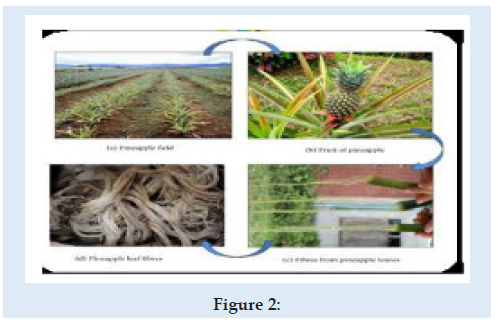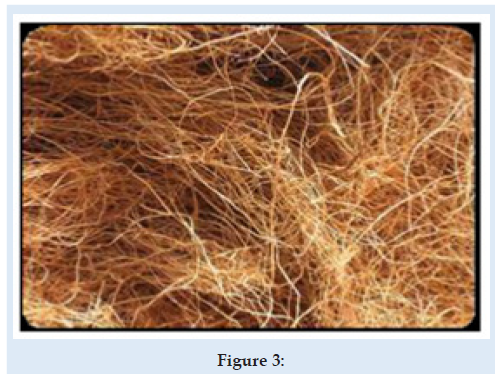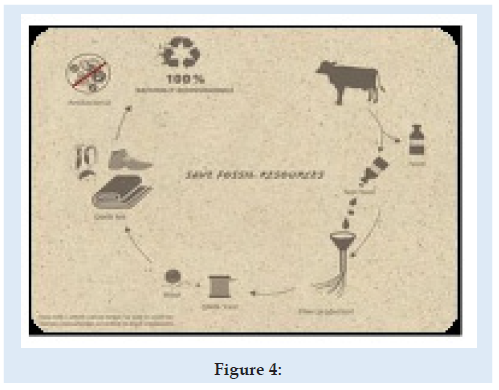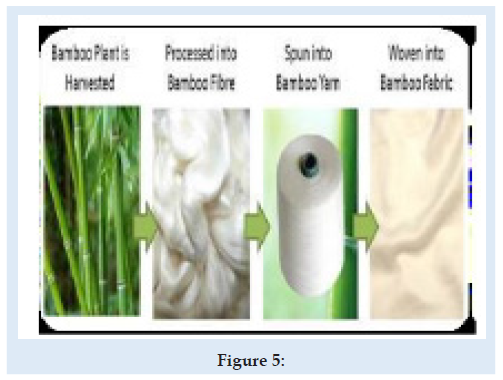
Lupine Publishers Group
Lupine Publishers
Menu
ISSN: 2637-4595
Review Article(ISSN: 2637-4595) 
Food Fashion – An Innovative Concept in Costume Design Volume 5 - Issue 1
Shaistha Shabnam and N Gokarneshan*
- Department of Research and PG Studies in Home Science, Justice Basheer Ahmed Sayeed College for Women, India
Received:June 16, 2022 Published: July 07, 2022
*Corresponding author: N Gokarneshan, Department of Fashion Design, Hindustan Institute of Technology and Science, Chennai, India
DOI: 10.32474/LTTFD.2022.05.000202
Abstract
- Abstract
- Introduction
- Objectives
- Natural- Food Fibres Giving a New Concept in Costume Design
- Difference Between Natural Fibre Fashion and Man-Made Fibre Fashion
- Environmental Impacts of Food Fibre
- Different Types of Food Fiber Used in Clothing
- The Fast-Changing of Eco-Friendly Materials
- Impact of Yesterday’s Trash as Today’s Treasure in Fashion Industry
- Conclusion
- References
Food fashion is a new concept which is emerging in fashion world and has a huge impact on the fashion industry. Food fashion is created according to theme selection and many designers are adopting their new concept in their designs. Now a day’s food is a new fashion to get inspired to costume design. Various food items are used to create fibers which can eventually turn into fabrics. These types of fabrics can be recycled and reuse and are known as eco-friendly fibres. They are having good strength, good drape ability, durability, rough and tuff and some fibers having natural antiseptic properties. Eco-friendly fabrics do not require any pesticides or chemicals to grow. They are naturally resistant fungus and are disease free which make consumers to think about an alternative and does not contain irritating chemicals. These are bio-degradable and do not produce harmful toxins when degrade as synthetic fibres. These are breathable fibres which feel better if worn. Many people have skin problems which may be cured if used.
Keywords: Food; Fashion; Designers; Fibre; Fabric; Antiseptic
Introduction
- Abstract
- Introduction
- Objectives
- Natural- Food Fibres Giving a New Concept in Costume Design
- Difference Between Natural Fibre Fashion and Man-Made Fibre Fashion
- Environmental Impacts of Food Fibre
- Different Types of Food Fiber Used in Clothing
- The Fast-Changing of Eco-Friendly Materials
- Impact of Yesterday’s Trash as Today’s Treasure in Fashion Industry
- Conclusion
- References
Costume refers to a style of dress of particular nation, class, period etc. costume design refers the investing on cloth and the overall appearance of a performer. A designer who uses their creativity to design costumes for entertainment purpose is called costume designer. The idea to design costume is to reflect the vision and creativity of the designer and help performers to perform their act on screen [1]. Food fashion means fashion connected with food. The word “food fashion” can be used in two different ways having different meanings. Like in restaurants it means the interior of the restaurant, the dining quality & quantity, the varieties of food which are offered by the restaurants and on another hand, in the world of fashion it means a vast source of inspiration for apparel ranging from every day, wear to fashion to theatrical costumes. Food and fashion are two different things when hooked up together form a new creation. As a fashion designer, a designer can be inspired by anything which may also include food, monuments, season etc. They use different fruits, vegetable {edible items} to make their design attractive. Nowadays designers are getting motivated by food. Some designers meet different chefs and get inspired and try to use their different recipes and food on their garment [2]. Designers and their creative ideas can be represented with food products at fashion week including different themes. Food and fashion both are giving beautiful aspects nowadays. Vegetables are used as a motive on the garment. Researchers are now using food for making fabric. Such as leftover of pineapple is used to make pina fiber. Basically, food concept is very interesting on fashion as the designers also get to wonder from street food to restaurants knowing about different food on their costumes.
Objectives
- Abstract
- Introduction
- Objectives
- Natural- Food Fibres Giving a New Concept in Costume Design
- Difference Between Natural Fibre Fashion and Man-Made Fibre Fashion
- Environmental Impacts of Food Fibre
- Different Types of Food Fiber Used in Clothing
- The Fast-Changing of Eco-Friendly Materials
- Impact of Yesterday’s Trash as Today’s Treasure in Fashion Industry
- Conclusion
- References
a) To find out how food fibres can be used as a new concept in costume design.
b) To differentiate between natural fibre and man-made fibre in fashion.
c) To explain how natural fibres are beneficial in antibacterial and protect from ultra-violet rays.
d) Environmental impacts of natural fibre.
e) To analyze how natural fibre made garment has an impact on fashion and textile industry.
f) To evaluate the success of natural fibre in activation of fashion project and as an awareness-raising exercise.
Natural- Food Fibres Giving a New Concept in Costume Design
- Abstract
- Introduction
- Objectives
- Natural- Food Fibres Giving a New Concept in Costume Design
- Difference Between Natural Fibre Fashion and Man-Made Fibre Fashion
- Environmental Impacts of Food Fibre
- Different Types of Food Fiber Used in Clothing
- The Fast-Changing of Eco-Friendly Materials
- Impact of Yesterday’s Trash as Today’s Treasure in Fashion Industry
- Conclusion
- References
Food and fruit fibres are showing new concepts in costume designing because it has created awareness among consumers have encouraged many designers to adopt new designs and techniques that supports environmental responsibility and create fashion sustainably, allowing customers for safe, eco-friendly alternative.
Difference Between Natural Fibre Fashion and Man-Made Fibre Fashion
- Abstract
- Introduction
- Objectives
- Natural- Food Fibres Giving a New Concept in Costume Design
- Difference Between Natural Fibre Fashion and Man-Made Fibre Fashion
- Environmental Impacts of Food Fibre
- Different Types of Food Fiber Used in Clothing
- The Fast-Changing of Eco-Friendly Materials
- Impact of Yesterday’s Trash as Today’s Treasure in Fashion Industry
- Conclusion
- References
Food fibres
(Figure 1) Food fibres are those fibres which are made from the waste material- fruit peel or pulp of the fruit. These are also known as eco-friendly fibre such as pineapple, banana, coconut, milk, orange etc. The properties of these fibres are
a) Quick dry: These fibres have low water absorbency.
b) Strain proof: These fibres are challenges to both aqueous and oil-based stains.
c) Wind blocking: Prevent the flow of air through fabrics while under pressure.
d) Ultraviolet Rays protection: The maximum UV protection (UPF) rating of the fibre is 50+.
e) Anti-bacterial: These fibres have antimicrobial properties naturally present in them.
f) Skin care and Fragrance: These fibres release fragrance if skin care chemical or medicines are gradually trapped in layers with microcapsules.
Natural fibres are those fibres which are extracted from plants and animals. Example: cotton, silk, wool, and jute.
Man-made fibres are those fibres which are developed by man. Example: polyester, nylon, rayon etc These fibres are not environment-friendly and are harmful like- Polypropylene. These fibers are generally made up of synthetic materials such as petrochemicals.
Benefits of Food fibers
Research scientists had discovered a new way of fabric, this fabric possesses fighting ability against the sun harmful and damaging UV radiation rays and has anti-bacterial properties [3]. These fabrics are dyed with special chemicals which absorbs UV rays which results in the reduction of bacterial presence in the fabric. This fabric is beneficial to the skin. It is a perfect type of clothing for people who have skin problems and allergies.
Environmental Impacts of Food Fibre
- Abstract
- Introduction
- Objectives
- Natural- Food Fibres Giving a New Concept in Costume Design
- Difference Between Natural Fibre Fashion and Man-Made Fibre Fashion
- Environmental Impacts of Food Fibre
- Different Types of Food Fiber Used in Clothing
- The Fast-Changing of Eco-Friendly Materials
- Impact of Yesterday’s Trash as Today’s Treasure in Fashion Industry
- Conclusion
- References
Clothing made of food fibres from the stage of fibre to garment and textile products creates a lot of environmental impacts. Some of them are:
No Wastewater treatment required
In the processing of textiles lots of water is being used for dyeing and finishing processes. This water is being wasted as it is highly contaminated with acid, base, starch, and other harmful chemicals. Many countries have water treatment plant installed in their working areas. In the textile industry, they pre-treat wastewater before discharging into the sewage system. While if food fibres are used, they don’t require any chemicals process, so no water is used to remove them. Hence, water treatments are required because they can be normally washed [4].
Bio-degradable
It means that waste which can be broken down by bacterial actions. As food fibres or garments are made by natural food it easily gets decompose by bacteria without causing any harm to the environment and results in waste reduction. Whereas garments made of other fibres are not easily degradable and result in waste.
Recycling
Means to reuse the material repeatedly. Garments made of food fibres can easily be recycled as they are made of eco-friendly materials.
Food and Fruit Fibre Garments have an Impact on Fashion and Textile Industry
Bananas, pineapples, coconuts etc. are all sustainable materials that are being used to make textiles and garments. More companies are entering the textile and fashion industry to fight against the harmful environmental effects which are caused due to textile production. Due to the innovation of these food fibres people are getting more conscious about their skin and environment. New and emerging designers have a good platform to showcase their creativity ability to the world. Food fibres can be used as an alternative to different fibres which may be or are harmful [5]. For example, food fibre can be used as an alternative for leather. As leather is very polluting and expensive product whereas same quality is found in pineapple fibre. So, pineapple fibre can be used as an alternative for leather.
The Success of Food Fibre Fashion
The reason for the success of food fibre in fashion is that they are eco-friendly and biodegradable. For example, coconut coir has the ability to dry faster if compared with polyester. These fibres have a natural odor and tend to absorb sweat and minimize bad smells, without the use of harmful chemicals. These textiles protect from UV rays. The fabric is extremely durable, delicate, less toxic, and easy to produce glossy, soft, and translucent. These fabrics are cheaper if compared to leather. The fabric can be easily blended with other fabrics, dyed, and cleaned. Example: milk fabric helps to regulate both blood circulation and body temperature. This is the reason why food fibre is very successful in the fashion world.
Different Types of Food Fiber Used in Clothing
- Abstract
- Introduction
- Objectives
- Natural- Food Fibres Giving a New Concept in Costume Design
- Difference Between Natural Fibre Fashion and Man-Made Fibre Fashion
- Environmental Impacts of Food Fibre
- Different Types of Food Fiber Used in Clothing
- The Fast-Changing of Eco-Friendly Materials
- Impact of Yesterday’s Trash as Today’s Treasure in Fashion Industry
- Conclusion
- References
Pineapple fibre: (Figure 2) Pineapple fibre is made out of pineapple leaves. Fabrics made out of pineapple fibres are termed as Piña. Piña is derived from the Spanish word Piña which means pineapple. Pineapple fibres obtained from pineapple leaves were mostly used in the Philippines but nowadays it has come into the world of fashion. It can be combined with silk or polyester to create a textile fabric. Pineapple is basically grown in sub-tropical countries like India, Philippines, Taiwan, Brazil, Bangladesh, Hawaii, Indonesia and the West Indies. Pina fabric has its own history [6].
Coconut fiber: Coconut fibre is a natural fibre. It is extracted from the coconut husk. The fabric is known as Coir.It is used in the products like- floor mats, mattress, doormats, fishnets, and brushes. Coir, fibrous material which is found between the hard and internal shell, and which is on the outer part of coconut shell. The other uses of coir which is made from ripe coconuts are upholstery padding, sackcloth, and gardening (Figure 3).
Milk fibre: Milk fibre is made up of milk protein. When liquid milk is dried, its protein is extracted. This separated protein is then dissolved in chemical solution and then spun purely with wool, silk, cotton etc. These fibres can be spun into yarn and then woven into fabrics. It is a fibre which lubricates the skin. It helps to maintain the moisture of the skin, to reduce wrinkles and to soften the skin. That’s why, In earlier times people use to take a milk bath. It can be used to make t-shirts, sportswear, sweaters, undergarments etc (Figure 4).
Bamboo fibre: Bamboo is the fastest growing plant in the world. It has a capability of growing up to four feet a day. Bamboo requires no irrigation or fertilizers. It is naturally soft, absorbs moisture, breathable fabric [7]. It is suitable to make tight t-shirt and socks because of anti-bacterial property and also suitable for summer clothing because of anti-ultraviolet in nature (Figure 5).
Banana fibre: is extracted from the barks and stems of a banana tree. Banana fibres are natural fibres. It consists of cellulose, lignin, and hemicelluloses. Neither they shrink nor their color fades after being washed. Fabrics made of banana fibre is a mixture of 60% cotton to give durability. It is used to produced hats, photo frames, handbags, belts etc. It can also be used for weaving of clothes, rugs, sarees etc. (Figure 6).
The Fast-Changing of Eco-Friendly Materials
- Abstract
- Introduction
- Objectives
- Natural- Food Fibres Giving a New Concept in Costume Design
- Difference Between Natural Fibre Fashion and Man-Made Fibre Fashion
- Environmental Impacts of Food Fibre
- Different Types of Food Fiber Used in Clothing
- The Fast-Changing of Eco-Friendly Materials
- Impact of Yesterday’s Trash as Today’s Treasure in Fashion Industry
- Conclusion
- References
Environmental clothing consists of eco-friendly materials. According to textile ecology, Eco-friendly materials are not contaminated and don’t cause pollution to the environment in the process of production. It does not cause any harm to the human body. It is friendly to the environment and beneficial to humans [8]. No wonder if green natural fiber and green regenerated fiber have been used in the environmental clothing. Eco-friendly fabrics like-cotton, bamboo fiber, natural silk, soybean fiber, milk fiber and corn fiber can be widely used in life. At the same time, a human has injected the traditional fibers into high-tech. Some new synthetic materials emerge at a historic moment which has the environment protection and corresponds to consumer needs. These new materials make up the shortcomings of the traditional green fiber in function and make the clothing more comfortable, breathable, and functional.
Impact of Yesterday’s Trash as Today’s Treasure in Fashion Industry
- Abstract
- Introduction
- Objectives
- Natural- Food Fibres Giving a New Concept in Costume Design
- Difference Between Natural Fibre Fashion and Man-Made Fibre Fashion
- Environmental Impacts of Food Fibre
- Different Types of Food Fiber Used in Clothing
- The Fast-Changing of Eco-Friendly Materials
- Impact of Yesterday’s Trash as Today’s Treasure in Fashion Industry
- Conclusion
- References
From past time costume has been dividing into four types.
a) Historical
b) Fantastical
c) Dance
d) Modern
Historical
In past time people used to waste food. People used to store their dress ones their wore and also used to dump them. They didn’t even know how to use food in clothing. They used different sculpture marks etc for their plays but never used food in clothing.
Fantastical
Fantastical costumes are those costumes which are imaginative, which in actual world does not exist. People can use food in their clothing but in past as they didn’t get this idea. But in some places people use food in their costume as it’s all about people’s imagination.
Dance
Well dance is a form of art which need flexibility. In past people didn’t not use food in dance. well because they thought that food was just used to eating not as a part of costume which people would use in their dresses while dancing. now also food is not used in dance as then the dresses will concentrate on their costume then dance, but as a piece of decoration they use food, like after their performance.
Modern
Well in 80s-90s people didn’t know that food fibres is something that exist. They used to waste food. They also know man-made, natural fibres.
a) Natural
i. Vegetable: cotton, linen, jute
ii. Animal: silk, wool
iii. Mineral: asbestos.
b) Man-made
i. Regenerated cellulose: rayon Viscose.
c) Nitrocellulose
I. Acetate: acetate, nylon
II. Synthetic: nylon, polyester
Earlier People used to make a garment made of natural or manmade fibre. But then the researchers researched and found fibre which can be made from food/fruits like bamboo, milk, pumpkin, sugarcane etc. Nowadays, it’s common that the garment is made up of food/fruit fibre. Models walk with food on their costume or as accessories such as a bracelet, neck piece, anklets etc. Garments made of food/fruit fibres are beneficial to health and environment. The fabric made of bamboo is harsh but can achieve softness by softening process, therefore it can be used for baby clothing, towels, and bed linen. The fabric is moisture absorbent and anti-bacterial.
Impacts of material/garments generation on the earth
Material and garments are a work concentrated industry. It has numerous working techniques which frame stream forms. Each procedure makes different impacts on the earth and human wellbeing. The solid impacts are appeared in the figure beneath Among every single above factor, the earth impact incorporates debilitate exhaust and wastewater, materials contaminations, utilization of vitality and water [9]. Those unsafe to human wellbeing and wellbeing incorporate exorbitant utilization of pesticides and formaldehyde and different chemicals, clamor contamination and air contamination in material and dress plants (Figure 7).
Conclusion
- Abstract
- Introduction
- Objectives
- Natural- Food Fibres Giving a New Concept in Costume Design
- Difference Between Natural Fibre Fashion and Man-Made Fibre Fashion
- Environmental Impacts of Food Fibre
- Different Types of Food Fiber Used in Clothing
- The Fast-Changing of Eco-Friendly Materials
- Impact of Yesterday’s Trash as Today’s Treasure in Fashion Industry
- Conclusion
- References
Prior ensemble was a piece of expertise which indicates feelings of the entertainer and brings group of audience thousand years back. However, these days designers have re-characterized outfits by outlining them and utilizing new ideas. As we have examined above, we have looked into on natural product fiber. Diverse sorts of organic product fiber are utilized as a part of making articles of clothing. There are numerous advantages of utilizing articles of clothing made up of sustenance fiber as they are skin and ecofriendly. They shield us from the harmful UV beams from the sun. Organic products, for example, pineapple, coconut, banana and so forth are utilized as a part of influencing saree, to belt and different adornments. While making texture and different embellishments from natural product/nourishment there is no wastage of water, and no chemicals are utilized while making them. They can be reused. We have likewise examined that fiber are of two kinds: natural and man-made.
References
- Abstract
- Introduction
- Objectives
- Natural- Food Fibres Giving a New Concept in Costume Design
- Difference Between Natural Fibre Fashion and Man-Made Fibre Fashion
- Environmental Impacts of Food Fibre
- Different Types of Food Fiber Used in Clothing
- The Fast-Changing of Eco-Friendly Materials
- Impact of Yesterday’s Trash as Today’s Treasure in Fashion Industry
- Conclusion
- References
- Anukrati Mehta (2011) The alternative.
- Charles Morley (2016) Fabric Made of Food.
- Mazharul Islam (2001) Kiron.
- Rajeev Kumar (2017) Prospects of Sustainable Fashion Design Innovation. International Journal of Textile and Fashion Technology (IJTFT) 7(6): 5-14.
- Swico fil (2004) Bamboo fibre identification rule, CTITI (China Textile Industry Testing Institute) p. 2-4.
- Todd Copeland (2011) Patagonia, How Eco-Friendly is Bamboo Fabric, really?
- (2022) Textiles and Garments from Fruit Bowl to Fabric: Sustainable Materials Set to Take Over the Textile Industry.
- Textile school.
- Textile and Clothing Technology pp. 28-29.

Top Editors
-

Mark E Smith
Bio chemistry
University of Texas Medical Branch, USA -

Lawrence A Presley
Department of Criminal Justice
Liberty University, USA -

Thomas W Miller
Department of Psychiatry
University of Kentucky, USA -

Gjumrakch Aliev
Department of Medicine
Gally International Biomedical Research & Consulting LLC, USA -

Christopher Bryant
Department of Urbanisation and Agricultural
Montreal university, USA -

Robert William Frare
Oral & Maxillofacial Pathology
New York University, USA -

Rudolph Modesto Navari
Gastroenterology and Hepatology
University of Alabama, UK -

Andrew Hague
Department of Medicine
Universities of Bradford, UK -

George Gregory Buttigieg
Maltese College of Obstetrics and Gynaecology, Europe -

Chen-Hsiung Yeh
Oncology
Circulogene Theranostics, England -
.png)
Emilio Bucio-Carrillo
Radiation Chemistry
National University of Mexico, USA -
.jpg)
Casey J Grenier
Analytical Chemistry
Wentworth Institute of Technology, USA -
Hany Atalah
Minimally Invasive Surgery
Mercer University school of Medicine, USA -

Abu-Hussein Muhamad
Pediatric Dentistry
University of Athens , Greece

The annual scholar awards from Lupine Publishers honor a selected number Read More...











